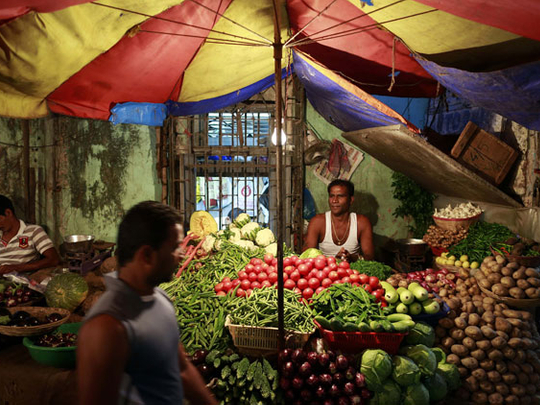
New Delhi: India’s battle with inflation and weak economic growth became more challenging on Thursday with a sharp spike in the cost of food driving the highest retail price rises on record and a worse-than-anticipated contraction in industrial production.
The data further complicates the central bank’s mission of cooling down prices without hobbling chances of a rebound — as well as adding to the government’s difficulties as it seeks a third term in a national election due by next May.
Sharply higher food prices drove up retail inflation to 11.24 per cent in November from 10.17 per cent in October. Food prices, politically sensitive in a country still marked in parts by extreme poverty despite its growing middle class, soared by an annual 14.72 per cent.
“We are very uncomfortable with the current level of inflation. I have said that at 10.1 and I will again say it at 11.24,” said the governor of the Reserve Bank of India, Raghuram Rajan, after the government released the data.
The central bank’s next meeting on monetary policy is on Wednesday.
Rising prices have forced the central bank under Rajan to raise interest rates at the last two meetings. With him determined to quash price pressures, the latest retail inflation data has increased the likelihood of another rate hike.
However, muddying policy, production at factories, mines and utilities shrank 1.8 per cent year-on-year in October after growing 2 per cent in September. The contraction was worse than 1.2 per cent forecast by economists in a Reuters poll.
“In a situation where you have high inflation and low growth you have to calibrate policy carefully. I’ve said there are some trade offs that we have to make,” Rajan said.
The data comes on the heels of a marginal pickup in economic growth in the last quarter from a four-year low. Asia’s third largest economy expanded an annual 4.8 per cent in the quarter through September, raising hopes for stronger growth.
However, the latest production data suggests the recovery remains fragile.
“After a run of more encouraging data recently, figures just released on Indian industry and inflation should help bring expectations for the economy back down to earth,” said Mark Williams, chief Asia economist at Capital Economics.
STINGING INFLATION Stubbornly high inflation, led by runaway vegetable prices, has battered India’s domestic demand driven growth. The production of consumer goods, a proxy for consumer demand, fell an annual 5.1 per cent in October. The sector has grown just once in last six months.
Asia’s third-largest economy has been caught in a situation that some analysts define as stagflationary for the past four quarters — with growth stuck below 5 per cent and prices rising.
That is a major worry for the ruling Congress party as it struggles to win back voters before an election barely five months away.
High food prices, especially for onions, have in the past been blamed for bringing down governments in India. The Congress party received a thrashing in four state elections over the past month following a sustained spike in prices.
C. Rangarajan, the chief economic adviser to the prime minister, said he expected food prices to start coming down by December. That view matches signals from wholesalers who say supplies of onions are rising in the main producer states.
Opposition prime ministerial candidate Narendra Modi has made reviving the economy a central plank of his campaign. The Congress party is pinning its hopes on an economic rebound ahead of national elections to counter Modi’s surge.
Hopes of an economic recovery are reliant on higher rural consumer spending after a strong monsoon raised farm output and a rebound in merchandise exports. But that alone is not enough to take growth back to the 8 per cent rate the government says is needed to reduce poverty and generate jobs.
Economic growth virtually halved in two years to 5 per cent in the fiscal year that ended in March — the lowest level in a decade in which the Congress party has dominated Indian politics. Most economists surveyed by Reuters in October expect the fiscal year to March 2014 to be worse.












